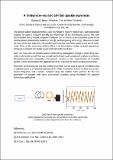Files in this item
A femtometer-resolved all-fiber speckle wavemeter (Conference Presentation)
Item metadata
| dc.contributor.author | Bruce, Graham David | |
| dc.contributor.author | Chen, Mingzhou | |
| dc.contributor.author | Dholakia, Kishan | |
| dc.contributor.editor | Galvez, Enrique J. | |
| dc.contributor.editor | Andrews, David L. | |
| dc.contributor.editor | Glückstad, Jesper | |
| dc.date.accessioned | 2018-03-20T12:30:09Z | |
| dc.date.available | 2018-03-20T12:30:09Z | |
| dc.date.issued | 2018-03-14 | |
| dc.identifier | 252588088 | |
| dc.identifier | 5211dd6b-e308-4da5-aef0-b132ba91f2ff | |
| dc.identifier.citation | Bruce , G D , Chen , M & Dholakia , K 2018 , A femtometer-resolved all-fiber speckle wavemeter (Conference Presentation) . in E J Galvez , D L Andrews & J Glückstad (eds) , Complex Light and Optical Forces XII . , 105490N , Proceedings of SPIE , vol. 10549 , SPIE , SPIE Photonics West 2018 , San Francisco , California , United States , 27/01/18 . https://doi.org/10.1117/12.2289636 | en |
| dc.identifier.citation | conference | en |
| dc.identifier.issn | 0277-786X | |
| dc.identifier.other | ORCID: /0000-0003-3403-0614/work/42734894 | |
| dc.identifier.other | ORCID: /0000-0002-6190-5167/work/47136401 | |
| dc.identifier.uri | https://hdl.handle.net/10023/12979 | |
| dc.description.abstract | The speckle pattern produced when a laser illuminates a random medium can, with appropriate analysis, be used to uniquely identify the wavelength of the illuminating source. We have demonstrated that principal component analysis can be used as a very sensitive probe of the speckle pattern produced by random prisms [1] and integrating spheres [2]. However, to date, the state-of-the-art realisations of speckle spectrometers have been based on the use of multi-mode fibres as the scattering medium [3] and on transmission matrix analysis approaches, achieving a compact and stable device with picometre resolution. Here, we show that the speckle pattern produced by propagation through a metre-long step-index multi-mode optical fibre can be analysed with principal component analysis to achieve a femtometre-precision wavemeter, and present progress in the measurement of complete spectra, which demonstrates the applicability of our approach to many existing experiments. Moreover, we demonstrate that the speckle wavemeter can be used as part of a feedback loop to stabilise lasers to a fractional stability of 10-9. With the freedom to lock the laser at any user-desired frequency and a robust, compact setup, the method holds promise for the new generation of portable cold atom experiments currently being developed for quantum technology applications. [1] M Mazilu, et al. Opt Lett 39, 96 (2014) [2] N K Metzger, et al. Nat. Commun. 8, 15610 (2017) [3] H Cao, J. Opt. 19, 060402 (2017) | |
| dc.format.extent | 94926 | |
| dc.language.iso | eng | |
| dc.publisher | SPIE | |
| dc.relation.ispartof | Complex Light and Optical Forces XII | en |
| dc.relation.ispartofseries | Proceedings of SPIE | en |
| dc.subject | QB Astronomy | en |
| dc.subject | TK Electrical engineering. Electronics Nuclear engineering | en |
| dc.subject | NDAS | en |
| dc.subject.lcc | QB | en |
| dc.subject.lcc | TK | en |
| dc.title | A femtometer-resolved all-fiber speckle wavemeter (Conference Presentation) | en |
| dc.type | Conference item | en |
| dc.contributor.institution | University of St Andrews. School of Physics and Astronomy | en |
| dc.contributor.institution | University of St Andrews. Biomedical Sciences Research Complex | en |
| dc.identifier.doi | https://doi.org/10.1117/12.2289636 |
This item appears in the following Collection(s)
Items in the St Andrews Research Repository are protected by copyright, with all rights reserved, unless otherwise indicated.

